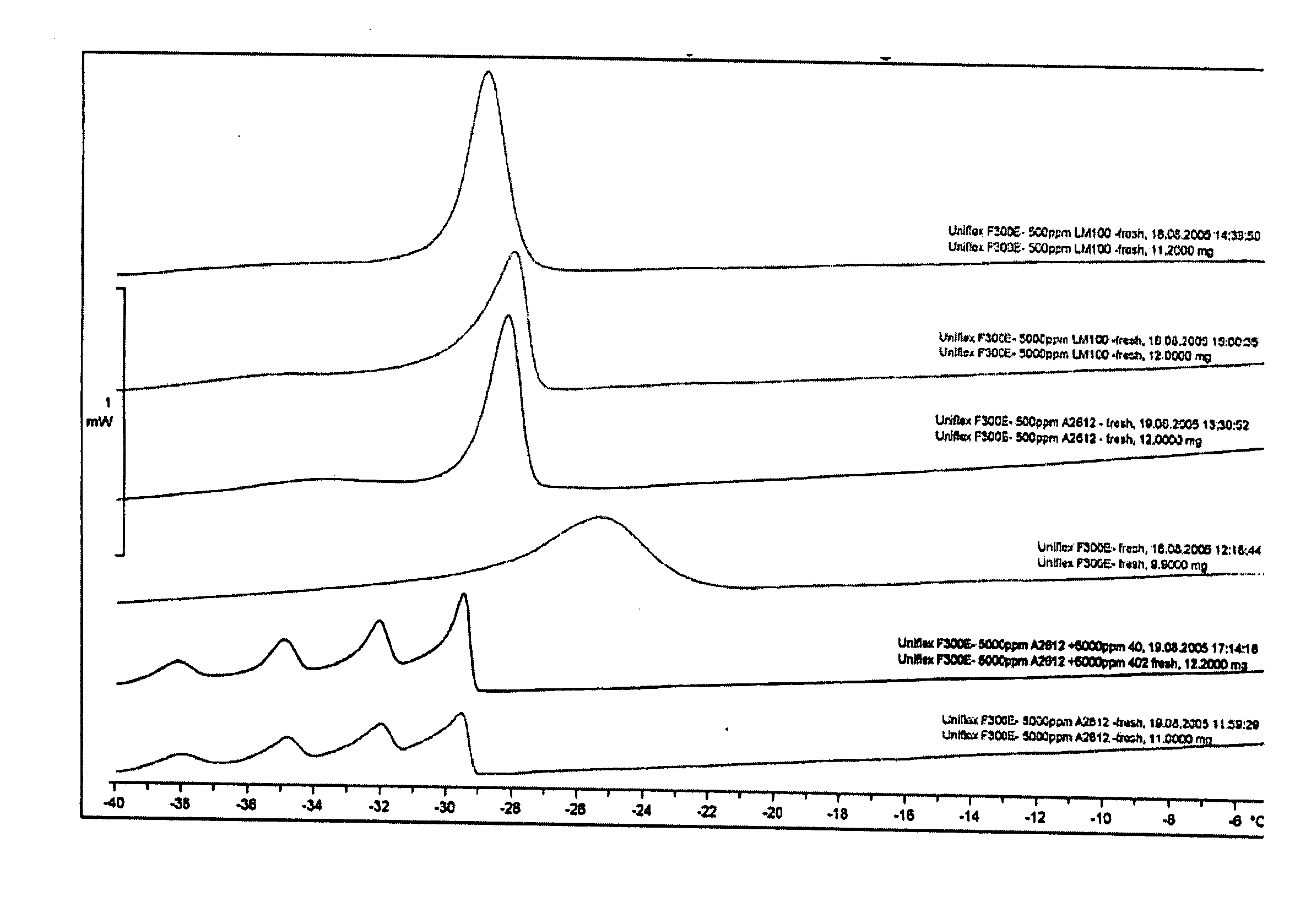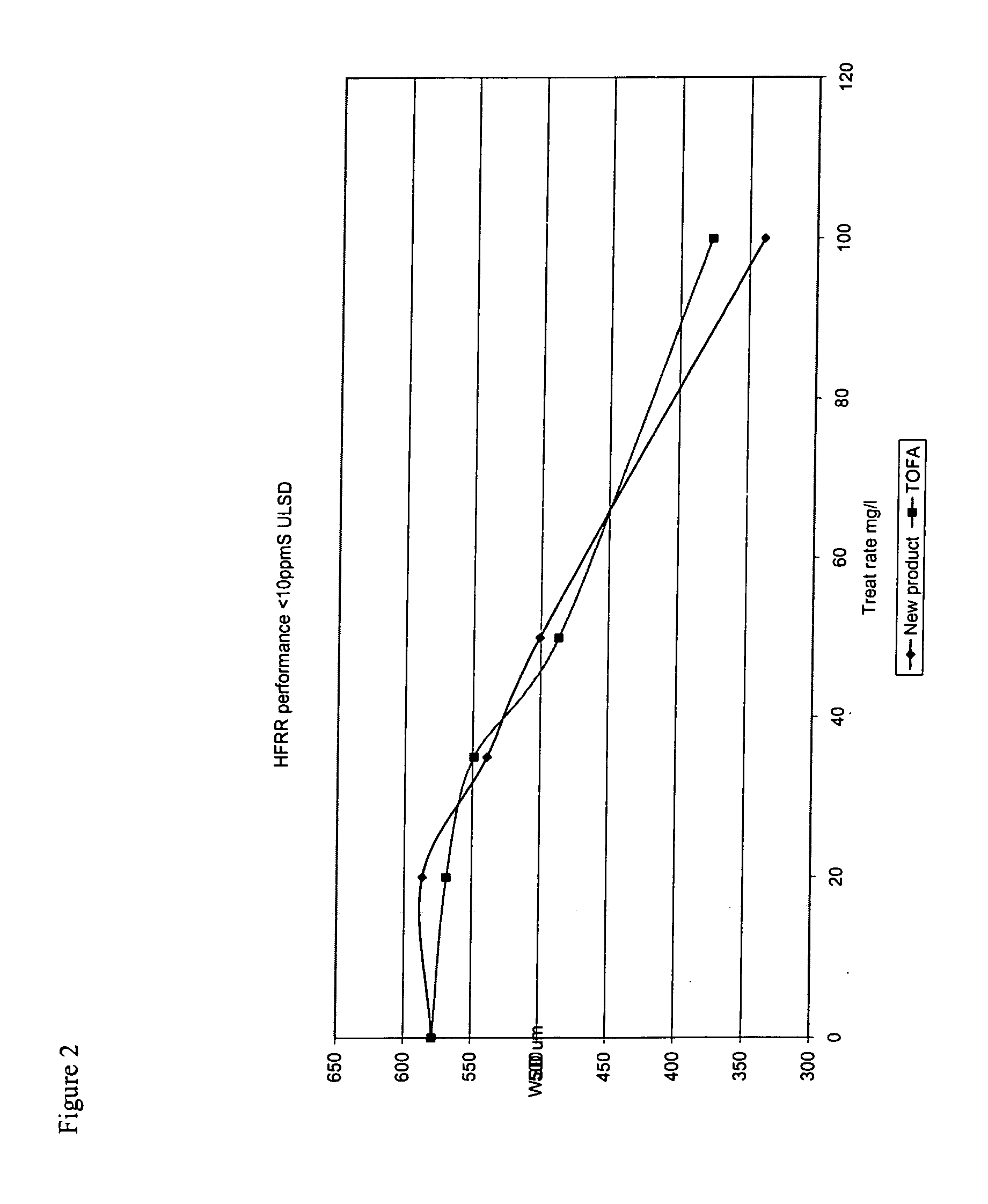Compositions containing fatty acids and/or derivatives thereof and a low temperature stabilizer
a technology of fatty acid derivatives and stabilizers, which is applied in the direction of biofuels, make-up, fuels, etc., can solve the problems of low temperature precipitation of fatty acid components, low temperature handling stability, and handling instability that is often observed, so as to improve the low temperature stability and/or low temperature performance
- Summary
- Abstract
- Description
- Claims
- Application Information
AI Technical Summary
Benefits of technology
Problems solved by technology
Method used
Image
Examples
example 1
[0152] The preferred polyamides can be dissolved in the fatty acid using heating and stirring if nessassary. The actual dissolving can take place below the softening / melting point of the polyamide. After the polyamide is dissolved additional solvent can be added to achieve the desired cloud point or viscosity. The addition of solvent can take place at elevated temperatures, but at least above the cloud point temperature of the neat fatty acid to avoid crystallization.
[0153] Alternatively, the fatty acid, polyamide and solvent can be mixed together in the desired concentrations and heated and the mixture stirred until the polyamide is dissolved.
[0154] The following data are examples to show the working principles. They are not optimized to achieve the maximum effects nor are they extensive lists of all possible combinations. The error margin for the cloud point measurements is + / −2 C.
[0155] In Table 1 the cloud points in degrees Celsius are given for the fatty acid Sylfat 2LT with...
example 2
Long-Term Low-Temperature Storage Stability
[0164] Five samples were prepared having the compositions set forth in Table 9. Each sample was stored at 0° C. and visually inspected (at 0° C.) every 7 days for 28 days. Visual inspection subjectively judged the clarity of the sample, on a scale of 0-10, where 0 denotes a clear and bright sample, and 10 denotes a solid, opaque sample; so that lower numbers are more desirable. A sample typically develops opacity due to the precipitation of one or more components from the sample. Therefore, as clarity decreases, the solids content of the sample tends to increase. This experiment was repeated, with the results shown in Table 10.
TABLE 9CLARITY OF SAMPLES STORED AT 0° C. FOR 28 DAYSDaysSample7142128TOFA 1 (a)4577BCFA 1 (b)4476BCFA 2 (c)888895% (a) + 5% (b) (wt %)233395% (a) + 5% (c) (wt %)2233
[0165]
TABLE 10CLARITY OF SAMPLES STORED AT 0° C. FOR 28 DAYSDaysSample7142128TOFA 1 (a)2444BCFA 1 (b)4476BCFA 2 (c)888895% (a) + 5% (b) (wt %)111295% ...
example 3
[0167] Five samples were prepared having the compositions set forth in Table 11. The cloud point of each of these samples was measured using an automatic cloud point tester (Herzog HCP852 Cloud and Pour Point tester) carried out in accordance with ASTM D2500 / IP219 / ISO3015, where the cloud point of each sample is also shown in Table 11.
TABLE 11CLOUD POINTSSampleCloud Point (° C.)TOFA 1 (a)−8BCFA 1 (b)0BCFA 2 (c)−295% (a) + 5% (b) (wt %)−1095% (a) + 5% (c) (wt %)−9
[0168] The data demonstrate that the combinations of fatty acids and branched chain fatty acids have a lower cloud point, i.e., will remain stable at lower temperatures for longer times, than either the fatty acids or the branched chain fatty acids alone.
PUM
| Property | Measurement | Unit |
|---|---|---|
| temperature | aaaaa | aaaaa |
| temperature | aaaaa | aaaaa |
| weight percent | aaaaa | aaaaa |
Abstract
Description
Claims
Application Information
 Login to View More
Login to View More - R&D
- Intellectual Property
- Life Sciences
- Materials
- Tech Scout
- Unparalleled Data Quality
- Higher Quality Content
- 60% Fewer Hallucinations
Browse by: Latest US Patents, China's latest patents, Technical Efficacy Thesaurus, Application Domain, Technology Topic, Popular Technical Reports.
© 2025 PatSnap. All rights reserved.Legal|Privacy policy|Modern Slavery Act Transparency Statement|Sitemap|About US| Contact US: help@patsnap.com



